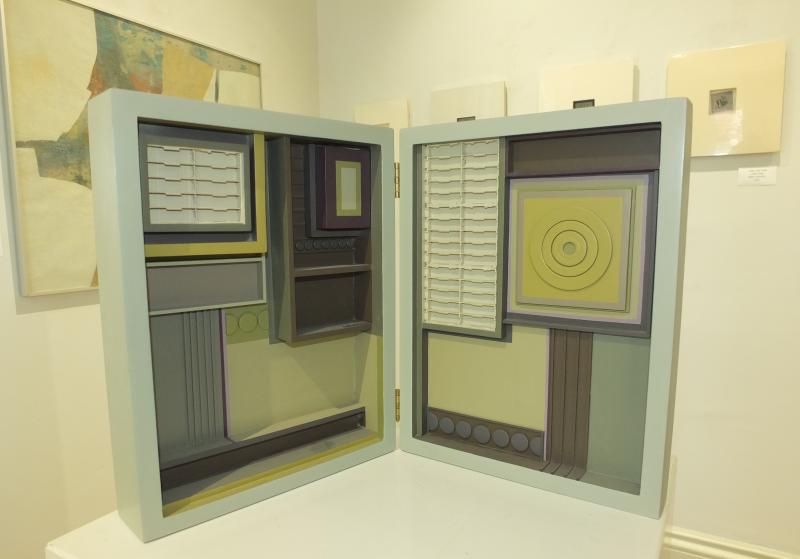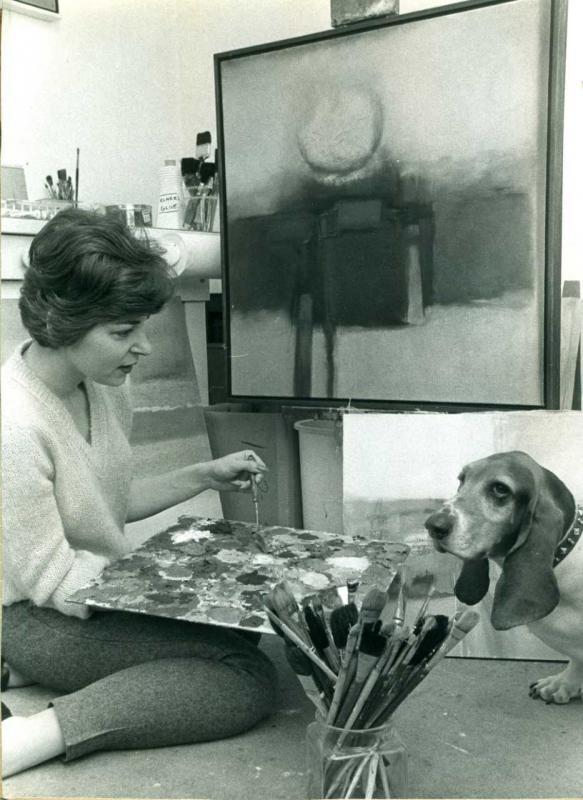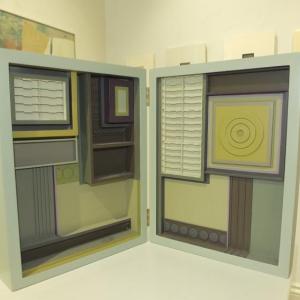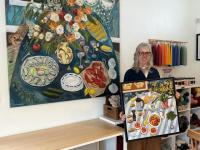Nancy Wilkoff: Artful assemblage
 Nancy Wilkoff’s boxed assemblage art is among the mediums in the artist’s ongoing show at Studio 53. Courtesy of Pam Riml
Nancy Wilkoff’s boxed assemblage art is among the mediums in the artist’s ongoing show at Studio 53. Courtesy of Pam Riml
 Nancy WIlkoff and basset hound Casey, circa mid-1950s. Courtesy of Pam Riml Writer’s note: I call this Nancy’s “Lauren Bacall lookalike” photo. Can’t you see the resemblance?!
Nancy WIlkoff and basset hound Casey, circa mid-1950s. Courtesy of Pam Riml Writer’s note: I call this Nancy’s “Lauren Bacall lookalike” photo. Can’t you see the resemblance?!
 Nancy Wilkoff’s boxed assemblage art is among the mediums in the artist’s ongoing show at Studio 53. Courtesy of Pam Riml
Nancy Wilkoff’s boxed assemblage art is among the mediums in the artist’s ongoing show at Studio 53. Courtesy of Pam Riml
 Nancy WIlkoff and basset hound Casey, circa mid-1950s. Courtesy of Pam Riml Writer’s note: I call this Nancy’s “Lauren Bacall lookalike” photo. Can’t you see the resemblance?!
Nancy WIlkoff and basset hound Casey, circa mid-1950s. Courtesy of Pam Riml Writer’s note: I call this Nancy’s “Lauren Bacall lookalike” photo. Can’t you see the resemblance?!
“WOW!” was artist Nancy Wilkoff’s response when her daughter, East Boothbay resident Pam Riml, told her Studio 53 was interested in showing her work.
The events leading up to this “wow moment” started when Pam arrived back home from Tucson where she had been packing up her mother’s art to bring to Maine.
“There was just so much work,” exclaimed Pam. “I didn’t know what to do with it. But I thought it was good, so I asked my neighbor, artist Tony van Hasselt, if he’d come over and take a look at it.”
Next thing Pam knew Terry Seaman, co-owner of Studio 53 with wife Heidi Seidelhuber, asked to come over and see the work he’d heard about from Tony. And the rest, as Pam says, is history.
“I thought I’d died and gone to heaven,” said Seaman about the work of Wilkoff. “I’m always looking for art like this in Boothbay Harbor, but I didn’t expect to find it!”
Seaman says that what Nancy does with the materials she uses is “magical and austere, elegant and profound.”
Wilkoff’s art includes paintings (most dating back to the 1950s), paper collage, boxed assemblage art, sculpture, and assemblage collage. Nancy’s fondness for word play is also reflected in her work. Take her sculpture of a dog bone wrapped in Chinese lettered paper from 2005 entitled, “Bone – Apetit.”
In a phone interview, Nancy recalled one of her favorite boxed assemblage works, a yellow one entitled, “Not For Perry Mason.” “Everyone wants to know why it’s called “Not For Perry Mason” and I say because it’s ... an open and shut case!” laughs Nancy. “That was my one genius moment!” Another work is of a grouping of large and small bones erected to look like Stonehenge entitled, “Bonehenge.” Bloody brilliant wit, that!
Nancy has lived in Tucson for the past 40 years. In 2008, a few of her boxed assemblage art works were featured in an edition of Phoenix Home & Garden. She described her “process” in creating them this way: “The boxes evolve with no preconceived idea. Choices can be spontaneous or well-edited; the only criterion is that these shapes contribute to the development of a new entity. If successful, recycled parts simply form elements, a vocabulary to describe positive and negative spaces.”
Nancy has always preferred to make her own boxes, hinges and all. She also preferred to make all of the colored sizes and shapes used in her collages by painting sheets of art quality paper in acrylic paints that, once dry, were cut into a variety of shapes and sizes. Pam notes that each color, each shape was contained in its own clear Dixie cup in her mother’s studio. “She was very meticulous,” says Pam. “It was a very small studio – I had to be organized!” replies Nancy.
Boxed assemblage collages were presented in a box frame, much like the shadow boxes manufactured today, and filled with found objects, often given to her by fellow artists, friends and others who heard she used odd materials in her art. For example, for awhile Nancy was collecting bones. A friend in Tucson found a dead snake in her yard and eventually passed its bones on to Nancy. “I boiled those bones in bleach and then dried them in the microwave,” Nancy recalled. “People knew that I’d collect anything – and sent or gave the most unusual things to me. I only used one-tenth of the stuff … I mean, how much junk can you collect?”
In addition to bones, Nancy used rocks, seeds, acorns, wood, rocks, metal scraps, wire, string, netting, buttons … As a young girl even Pam would contribute to her mother’s collection.
“When other kids were giving their mothers perfume or books or something, I would give my mother things like an old typewriter because she might be able to use the keys for something!” Pam said. “It was a very unusual childhood. I was always around artists. While some kids were going to some activity or other, I was at art galleries!”
Among the assemblage collages in box frame in Nancy’s current show, “(W)rap Session” is … sensational. About 20 bones of various sizes have been strung at different heights. The edging of the box appears to be wrapped in string as well. Interesting thing about this piece: if you gently tap the side of the box each of the stringed bones quiver, perhaps in resemblance to human vocal chords. It fits in with the artist’s play on words title of this piece of art.
“What I put in the boxes was a question of sorting through tons of stuff and placing it, taking it out, and replacing it with something else,” Nancy explained. “There wasn’t an ‘aha moment.’ I just kept doing it until it felt right. My inspiration was to have an overall design that worked and I just knew when it did and when it didn’t.”
The elements of design, good design, was something Nancy learned in Youngstown, Ohio, with Margaret Evans, a retired art director of the Butler Institute of American Art. Evans would invite a group of budding artists to her home where, at the dining room table, they would discuss art. Nancy says these group events were “the most helpful experience” she ever had.
“She gathered those of us who thought we were artists around the table and discussed art. Then, we would go home, make something and bring it with us the next day – and have it torn apart. That’s where the idea of a good design was pounded home … It was enormously helpful.” Nancy then added, laughing, “That’s what really started all my troubles!”
That “trouble” resulted in the creation of Nancy’s highly colorful collages, all labors of love, some of which are in homage to Evans. Several of Nancy’s series of “Emmie” collages are in the Studio 53 show. Said Nancy, “She was literally looking over my shoulder while I worked on some of them.”
Over the years, Wilkoff’s art has shown at, to name a few, Tucson galleries the Otero Gallery and The Obsidian Gallery, among others; and in the permanent collections of Butler Institute of American Art, Herman Miller Inc., IBM, Motorola, Portland (Oregon) Art Museum, Purdue University, and Tucson Museum of Art. Most of these were Purchase Awards, in which pieces were juried into exhibits and the purchase of a work constituted the award.
Pam has a couple three-ring binders, put together by Nancy over the past six decades, in the exhibit space on the left side of the first floor at Studio 53.
“It’s killing me to know that it’s going on and I can’t be there,” Nancy said about her show. Not to worry! Pam has sent her mother lots of pictures. “She’s sent me millions of them and I’ve been showing them around here in assisted living - to everybody! It’s still very exciting for me.”
Seaman says there is still a lot of work at the gallery not included in this show that was hung by Seidelhuber. “There is so much great stuff that I’m thinking of another show – but dedicating the entire first floor for Nancy’s work.”
Wilkoff is a Signature Member of the National Collage Society, a member of the Tucson/Pima Art Council Selection Panel for Public Art Projects in the mid-to-late 90s, and has been recognized as an “emerging artist” by Phoenix Home & Garden magazine.
See Wilkoff’s work for yourself. No doubt “wow” is what you’ll say too – everyone does. Studio 53, open 11 a.m. to 5 p.m. daily, is located at 53 Townsend Ave. in Boothbay Harbor. Call 633-2755 for more information.
Event Date
Address
53 Townsend Avenue
Boothbay Harbor, ME 04538
United States
























